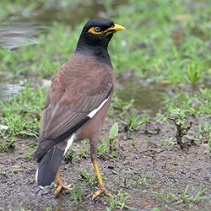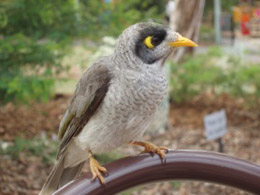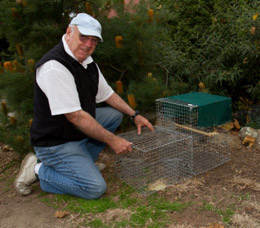ACT State of the Environment Report 2011
Accurate, timely & accessible information for the community regarding the condition of the environment, underlying pressures, and sustainability trends.
Sustainability Story: Controlling the Indian Myna- protecting native fauna
Download: Report Stories Controlling the Indian Myna- protecting native fauna.pdf
The Indian Myna, not to be confused with the Australian Noisy Miner, poses a serious threat to native wildlife, particularly those birds that nest in the hollows of trees. They are also considered a public nuisance. Their droppings foul backyards, schools and shopping centres; their nesting activities can create fire hazards, and their raucous calls and noisy roosting sites are difficult to ignore. In 2006 the Indian Myna was recorded as the third most common bird in Canberra.

The Indian Myna (Photo courtesy of Geoffrey Dabb)
A small group of Canberra bird watchers and conservationists were so concerned about the growing number of Indian Mynas in the Canberra region they decided to take action. The Canberra Indian Myna Action Group Inc. (CIMAG) and Myna control program began in April 2006. Using their own funds, they set about to undertake and promote their work building strong networks with government officers, academics, researchers, the RSPCA and community organisations. The groundswell of public support for control activities has turned the Program into a major community-action movement with around 1300 members.

The Noisy Miner (Photo courtesy of Bill Handke)
The Group is realistic in its aim of controlling Myna numbers rather than trying to eradicate the species. Their success is indicated by the continuing decline in Myna numbers over the past 5 years, with it now recorded as the 13th most common bird in Canberra. Program actions include trapping the birds and a public education program raises awareness of the problems posed by Mynas and what can be done about them.
Currently all control efforts are on private domestic land. With large numbers of Mynas found around shopping centres, schools and nature reserves, the main challenge for the Action Group now is to broaden the control program to public spaces in partnership with government and business.
The Canberra Indian Myna Action Group will continue to support activities based on sound science and animal welfare principles. Currently the Action Group is supporting two PhD research projects focussing on Indian Mynas. The success of the program demonstrates the ecological benefits of community-based action programs and has now inspired 26 similar groups across New South Wales.

A CIMAG member with a Myna Trap (Photo courtesy of Geoffrey Dabb)
For further information see the CIMAG website, indianmynaaction.org.au






Share this page: